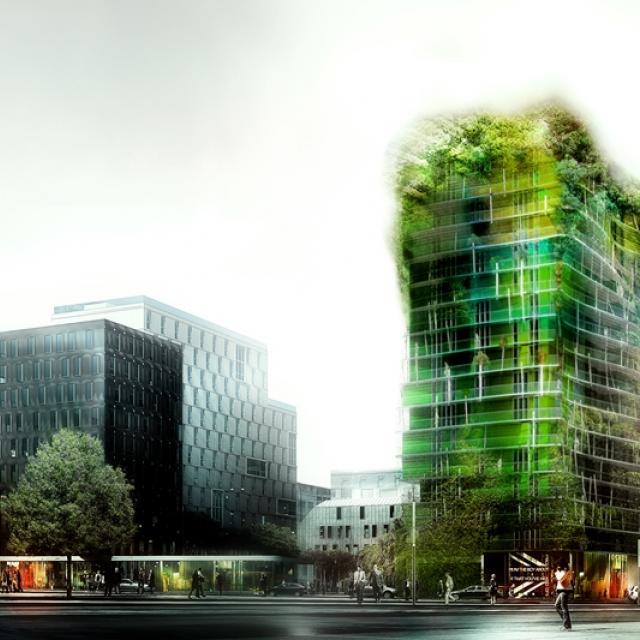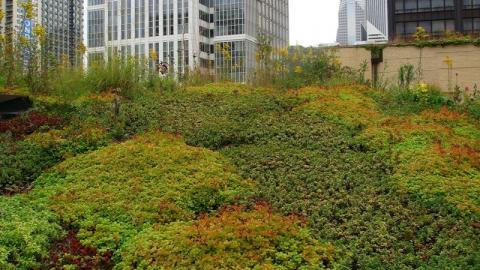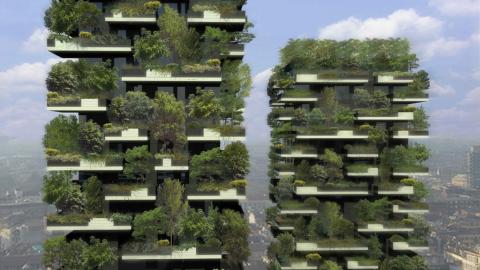Construction height is the ecological talking point discussed in every municipality: the city cannot extend indefinitely into the landscape and, therefore, densification is achieved by increasing the height of the urban infrastructure. Benefiting from an exception to the 37-metre building height restriction imposed in Paris, the tallest building, the M6B2 tower, situated in the XIII administrative division of Paris, is 50 metres high. Covered with wild species of plants, the Tower of Biodiversity will soon be covered with vegetation.

The project covers three buildings containing 140 social housing units, 1,200 m2 of commercial office space and an associative child care centre. The “M6B2” tower alone will accommodate 95 social housing units and offices on the ground floor and over the next 5 years will be covered with plant species. In the middle, there is a garden which extends, as a continuation of the green façade, as far as the foot of the other two buildings. These lower buildings, of simpler design and with metal facades (zinc, aluminium), are situated at the corners of the complex, bordering the street. Thus it is possible to stroll through the sheltered garden, between rows of shrubs and a mat of heath-like vegetation, just as if you were in the open countryside.
An outstanding feat of science
M6B2 is, in fact, the name of the plot. The tower has been named the Vertical Chameleon by its architect Edouard François. The « specialist » in sustainable urban architecture, by way of an example, designed “The Building That Grows” in the city of Montpelier and the first Tower Flower in Paris, built 10 years ago in the district of Porte d'Asnières (XVII), with its giant flower pots hanging from all the balconies. However, this particular 18-storey 50 metre high tower designed by Edouard François is even more innovative. It could even be called a scientific work of art.
The building is constructed out of titanium, a material with the characteristic, at a certain temperature and voltage, of being able to change colour without the need to add any other material. After a year and a half of work and tests, the architect was able to obtain an optimum level of fluorescence and the building will have exactly the right tone of moss green. Thus, this public housing unit of the future has become a veritable botanical conservatory.
Even more astonishing is the shear amount of vegetation on the building. Edouard François works in partnership with the Du Breuil School of landscape architecture. In order to confirm the “feasibility of installing and maintaining plants on the facades”, a scientific protocol was implemented. The school collected wild seeds from all of the forests in the Île-de-France region, selected for their capacity to grow in places that have extreme conditions. Twenty-two species have been collected and then sown at the school in long stainless steel tubes, 25 cm in diameter, in a mixture of soil, sand and compost; and they are grown with no nutrients applied and only limited irrigation. The experiment lasted 3 years.
The result has been truly spectacular: for growing these trees, the architect Edouard François was inspired by the mountain fir trees, which are able to develop in the most incredible of places, on rock walls, with very little soil. A total of 285 tubes accommodating species of shrubs found in the wild, are fixed to the tower’s balconies. There are oak trees, pines, shrubs… which could reach 5 metres in height. And the further up you go, the more trees you will come across. On the last floor, on the roof, on a large volume of soil, a forest has been planted, where birds and insects come to find shelter. A total of 500 trees adorn the building.
The whole complex is irrigated automatically
We then made our way to the titanium-clad tower with Florent Poissonnet, from the company JFL Concept, which has designed the whole irrigation system. The irrigation design study for the M6B2 project began in 2012. These studies were accompanied by a programme aimed at drawing up a 2-year testing protocol for this plant-laden building (2013/2015) and carried out by the Dubreuil School, so as to comply with the request made by Paris Habitat. These experiments allowed the players involved to observe the rooting pattern of the whole depth of the substrate in the tube, over a period of 2 years. The testing protocol also allowed the companies to decide on an operating method for installing the substrate, drip irrigation system and plants.
In the basement, there is a service room containing a pumping station, a remote controlled decoder controller, a filter and a fertigation dosing pump.
This unit supplies the project’s different irrigation systems with water and controls the scheduling, these systems being:
• The irrigation of the M6B2 tower (7 solenoid valves),
• The irrigation of the garden on the ground floor (5 solenoid valves),
• The irrigation of the plant holders on the tower roof (1 solenoid valve),
• The irrigation of the living roof of the crèche (3 solenoid valves),
• The irrigation of the wooden plant holders on the roof of the building on l’Avenue de France (one solenoid valve).
Potable water is used for the whole irrigation system. A primary network leads to levels -1 and -2 as well as the supply units. The pumping station is located in the service room on level -1. It consists of two pumps operated alternately, providing a backup in the event of a breakdown. As the tower has significant differences in level and height, this station was necessary because the normal water supply would not have the pressure required for the whole system. The disc filter has a mesh of 130µ. All of the irrigation water has to pass through this filter. The dosing pump is linked to a By-pass system. It will be operated when fertilisers need to be applied. The whole installation is monitored by a Hunter ACC controller.
We then went up to the tower’s seventeenth floor (R+15).
The view of Paris took our breath away. The vertical stainless steel tubes (2.5 m of substrate) of 3 m. in length and 25 cm in diameter are watered with Netafim’s Unitechline drip irrigation system inserted in the middle of the tube, in the substrate. It has been important to co-ordinate the laying of the substrate and the planting of the trees in order to ensure that they are located in the middle of the tube. An additional dripper is located at the top of the tube in order to comply with and adapt to the plant water requirements depending on the planting pattern and exposure to sunlight. The Unitechline and additional Techflow drippers allow the system to comply with the different needs of the plants, thus ensuring longevity. The Unitechline is designed to adapt drip irrigation to all types of green spaces. Higher up the tower, the stainless steel tubes are close to each other, whereas on the lower levels they are spaced further apart. There are 36 tubes per storey near the top of the tower, then 18, 9 and 5 per floor. The plant density is thus more luxuriant on the upper section of the tower. With regard to the installation of the secondary pipes, these are of a variable type and address the different constraints (stresses and strains, resistance or breaking strength, vandalism…). The pipes are made of stainless steel, galvanised iron, PVC and Polyethylene. In the service ducts of the tower, a primary network of PVC was installed, supplying the solenoid valves used in the irrigation of the tower. The layouts of these are variable, allowing groups of floors to be supplied according to the hydraulic constraints and in order to balance the networks.
We then went back down to the ground floor and headed for the garden. There is no lawn as such, but rather ferns, ground cover plants, ivy, shrubs and trees. These different species, planted in heath land and covered with pine bark, are also irrigated with the Unitechline drip irrigation system and coils of drip tubes with additional Techflow drippers are used for the trees.
Finally, a drip irrigation system is also installed in plant holders measuring 80 cm in height on the roof of the tower (R+16) and on the living roof of the child care centre building (R+1). The plants in the wooden plant holders are also irrigated with the Unitechline system on the roof of the avenue de France building. At this junction, stainless steel piping has been installed to join up each plant holder
Once the very specific work on the irrigation system has been completed and taking into consideration the various constraints of the project, the maintenance of the system over future years is a very important factor for Paris Habitat. The nature and frequency of the maintenance will be more important than the level of basic maintenance. Making regular interventions and constantly checking that the irrigation system is operating correctly will be the key to the success of the vertical plant project.


